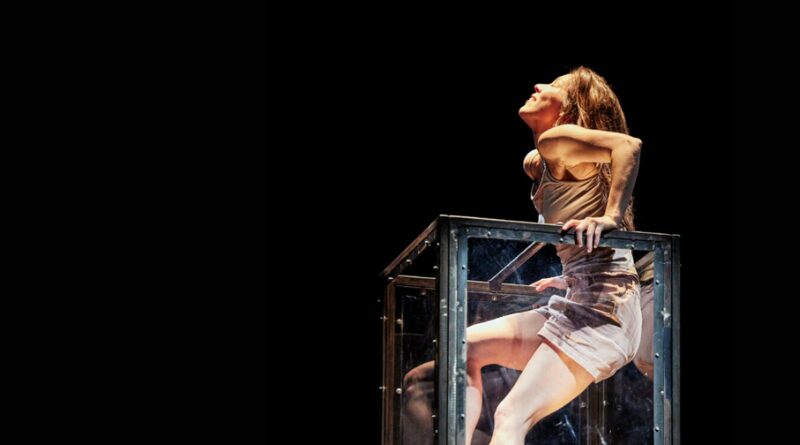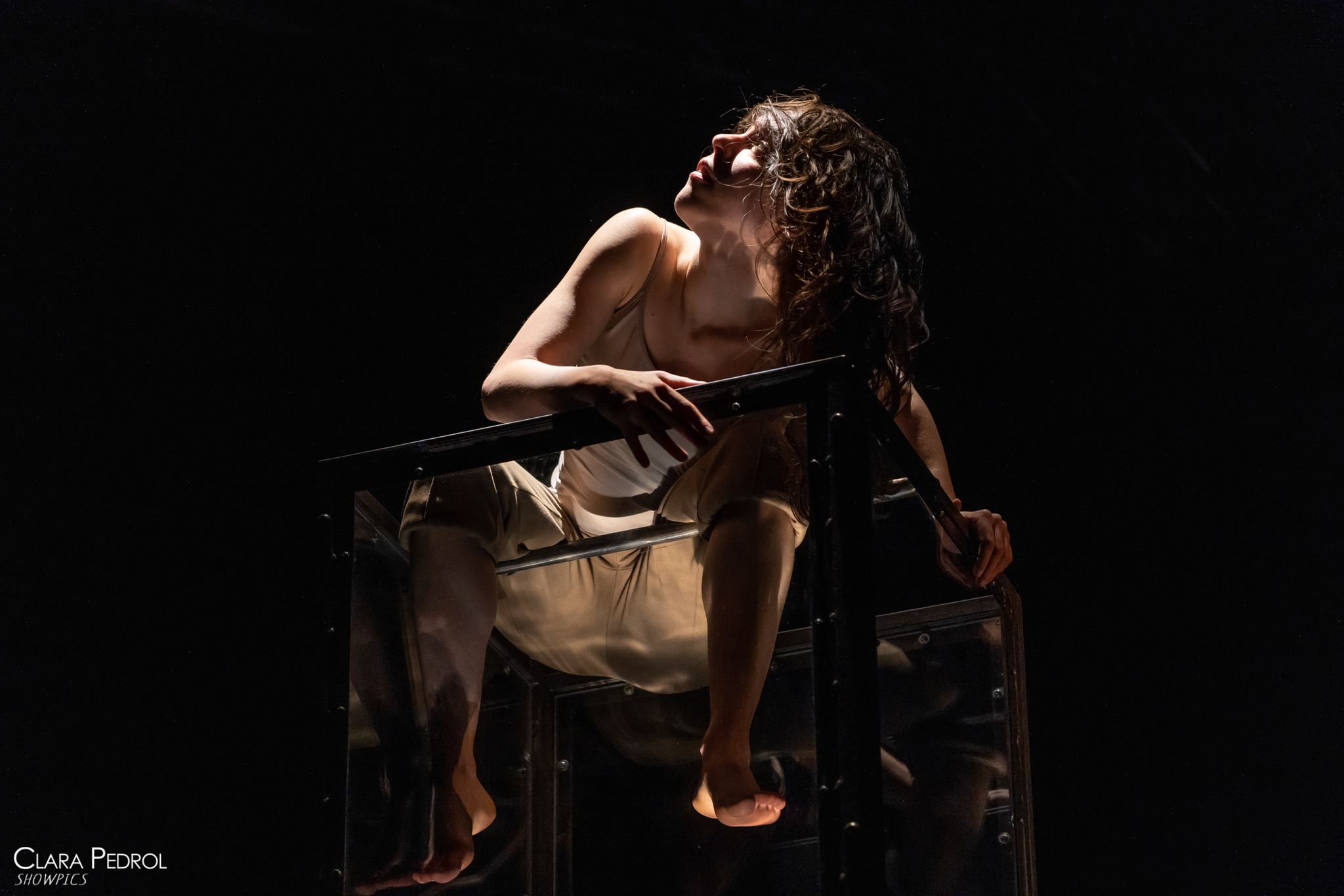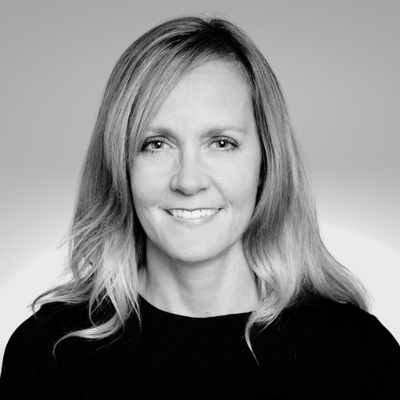Creating Circus Work – From Inspiration To Stage: The Performance
In this trilogy of circus artist interviews, we delve into the personal journeys of three solo artists whose work, in varying stages of development, was recently presented at UP Festival in Brussels.
In the third stage of the creation process is The Performance.
Performing one’s show to a spellbound audience is the culmination of countless hours of training, ideation, research, and rehearsal, coupled with boundless creativity. In this year’s UP Festival programming line-up, contortionist, circus researcher, and writer Alice Rende of Companie Ar presented her one-woman show,Fora. Here Rende chronicles her creation process and highlights both the team and the influences that inspired and supported her journey to the stage.
There is a box, so small, that forces her to contort her body. But once outside, is she really free? The contortions continue to reign over her body. Is she afraid of discovering herself to be monstrous? Or of transforming herself? Showing signs of her inner struggle, she continues to defy invisible walls. In Portuguese, Catalan, Sardinian, and Occitan, FORA means “outside.” Alice Rende’s solo combines the practices of flexibility and illusionism: enterology (the art of folding one’s whole body into a box that is obviously too small) and escapology (the art of escaping from one’s fetters). Despite these striking techniques, we can all recognize ourselves in this tug-of-war!
 Stacy Clark (SC): How and when did you get started in the circus arts, and who were your teachers, mentors and role models?
Stacy Clark (SC): How and when did you get started in the circus arts, and who were your teachers, mentors and role models?
Alice Rende (AR): At the age of 23, I was doing a Master’s research on the political power of the non-standard body on stage. It was through this university research that I came into contact with the circus arts. I enrolled at theescola nacional de circo in Rio de Janeiro out of curiosity.
I had a teacher from a traditional circus family, Delisier Reithy, who taught me to relativize all that is considered “classical” and “contemporary” in the circus arts and pushed me to research movements in the least obvious places. Then I got to know Olga Aidarkina, a contortion teacher who showed me that it was possible to learn this discipline that fascinated me without necessarily starting very early or being born with these skills. Finally, I met Roberto Magro, who directed my graduation show at the school and then invited me to take part in his creationSilenzio, in Barcelona. It was then that I went abroad and circus became a life choice for me. During this experience, Roberto asked me to perform rope in a plexiglass structure, and then we abandoned the rope and found new possibilities for interlocking circus movement, which I continued to develop.
Then I enrolled in a professional integration program offered by Esacto-Lido in Toulouse, and afterwards I wanted to return home to Brazil. But COVID forced me to stay in France. Strangely enough, my research with a plexiglass box corresponded to the rules of sanitary restraint, and I began to circulate and tour even before I’d finished writing my first solo with this apparatus. So I stayed in France. Meanwhile, I had the experience of working as a duo with Julia Christ in her creationLe Moindre Geste. Julia’s work made me realize that to find an interesting project, I need to feel that there’s something mysterious in what we’re looking for and sharing on stage.
SC: What was the genesis of your show concept?
AR: One day I realized that almost all my research, creations, texts, drawings, and poems have as their theme a desire for liberation, which often takes shape with the act or idea of escaping. It’s also the story of my life: many times I’ve felt that a place didn’t suit me and I needed to go somewhere else.
I thought it was funny to finally be able to consciously deal on stage with this theme that had been obsessing me for a long time without me realizing it. It was the start of myFora project. Little by little, the piece became a kind of fantastical autobiography, an autofiction. It’s about someone (me) who has trouble fitting into the space given to them, and who feels the need to open up their boundaries, to take up more space, to look elsewhere. You can interpret that in different ways, but my starting point was the feeling of inadequacy, of not fitting in, of not feeling understood or loved—of needing another space, another framework, other models, other relationships.
To feel loved, do we have to adapt, and fit into the restricted space of the other person’s gaze? Or is it better to find your own freedom? Does being free sometimes mean not fitting in?
I once read a book by Didi Huberman entitledThe Invention of Hysteria. The author argues that hysteria is a disease invented to give an explanation to women with different types of mismatch: too rebellious, too liberal, too promiscuous, too traumatized, too poor, abused, epileptic, too miserable, too ugly, too moody, too dreamy, sometimes too beautiful— that’s a danger, too!
For Huberman, the symptom of hysteria is the result of a staged event: patients were invited, sometimes even induced, to contort themselves. And they were photographed. This distorted symptom was used to frame them, to set them apart when it wasn’t possible to “cure” them, to force them to adapt.
Hysterics contort themselves: sometimes they are twisted inwards in malice and maladjustment, sometimes they open their bodies by leaning backwards—it’s a last resource and revolt against the constriction that the world imposes and that becomes unbearable.
It made me think that in the history of the circus, it’s often women who enter a small box: to show off their flexibility or be cut in half by a magician. And the heroic acts of escaping from boxes, chains, and handcuffs were often performed by men, like Houdini.
I wanted to mix and divert these two places: contortion as the act of limiting oneself, of bending, but also as a rebellious explosion that doesn’t accept limits, nor the limits of joints—that goes beyond to escape from any trapdoor, even the limits imposed by one’s own body, mentality, and references. A woman dares to escape: from whom? From others? From herself? Or only from what was given to her as possible?
But is it possible to exist by continuing to escape? Escape from what? From our frame of references? How can we live without references? To find/invite new frames of reference, we often talk about the ones we know… and it’s in these reflections that I built the end of this piece, which challenged and troubled me greatly.
SC: Describe the evolution of this work: for example, your acrobatic research, your dramaturgical process and your collaborations with other creators and technicians.
AR: I did two-three years of movement research before embarking on a creation. This research began in 2017 during theSilenzio residencies, with the guidance of Roberto Magro. Then I continued on my own.
In early 2019 I collaborated with Benet Joffre to build a plexiglass structure, tailor-made for me to be as narrow as possible so that I could move in it but it would impose contortion with every movement.
Also in 2019, I met magician Andrea Speranza, who has greatly nourished my imagination. At the same time, I often exchanged ideas with Jean Michel Guy, and we started talking about claustrophobia and liberation. In 2021, Gauthier Devoucoux cast a new light on the project—he’s a lighting designer. It changed the whole universe: reflections, smaller spaces, windows, and projections elsewhere. Gautier had a strong presence; he was the collaborator who followed most of the process, and we exchanged a lot on each dramaturgical choice.
In 2021, Chloe Levoy took the first steps towards sound, capturing and processing the noises generated by the movements and friction of the body against the plexiglass wall. Chloe and I were inspired by the music of Gaspar Claus, who squeaked his cello during a concert we enjoyed together.
At the end of 2022, I met composer Thomas Baudrillard, who turned squeaks into music, and thanks to him, the sound of slips and falls began to tell the story of flights of fancy.
In 2023, scenographer Kob built me a new, tiny box, like the ones used by contortionists in the 1920s. My body was measured several times, and I arrived at the last week of residency with this new prop, which required me to stretch even further and once again challenge my tolerance of claustrophobia.
During the last three days of creation, we had the presence of Michel Cerda, who asked us some pertinent questions about the show’s ending (tragic or hopeful?).
Finally, after the premiere, I started working with Clémence Drack and Alina Yanikeeva on production and diffusion, respectively, and with Julien Frenois and Léo Grosperrin on stage management. This show therefore represented the start-up and structuring ofCompagnie Ar.
SC: What has been your greatest challenge in creating a solo show?
AR: Getting along with myself.
SC: How have your past residencies (Projet Lauréat Circus Next – European Circus Label, Projet Lauréat SACD – Processus Cirque, Projet Lauréat Premiers Geste(s)) contributed to the work we see on stage today?
AR: Firstly, the partners, residencies, and awards gave me legitimacy. Without them,Fora would have stayed in my head without being able to materialize. What’s more, the project also represented for me the creation and structuring of Compagnie Ar. I received invaluable support from the Studio-PACT Pépinière pour les Arts du Cirque de la Grainerie in Toulouse; the Pôle de Cirque Archaos in Marseille; the Théâtre du Bois de l’Aune in Aix en Provence; and the Espace Périphérique at La Villette-Paris, among others.
Being a prizewinner of Processus cirque, circusnext, and Groupe gestes and co-produced by various partners enabled me to access the resources to put together the team that worked on this project. It also enabled me to build a touring network. Circusnext in particular helped me enormously with touring, and was instrumental in ensuring the show’s first year on the road.
...Do you have a story to share? Submit your news story, article or press release.







